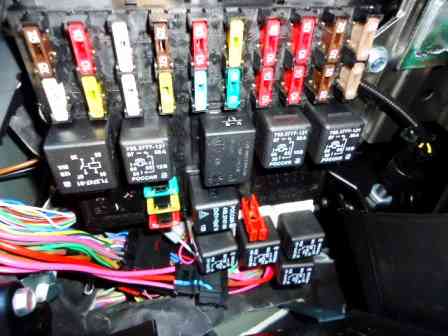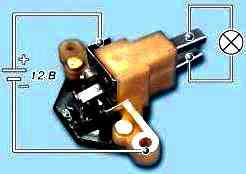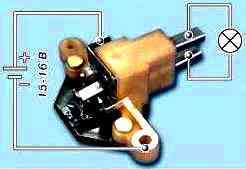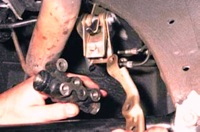There are two power sources on the car - a battery and a generator
The battery is used when starting the engine and to supply 12 V electric current to the starter and other consumers when the engine is not running
When the engine is running, the main current source - the generator - provides electric current to all consumers, including the ignition system, and charges the battery.

If the red battery discharge lamp lights up in the instrument cluster (pos. 16 in Fig. 1), it means that the current is not supplied from the generator to the on-board network and the battery energy is consumed.
This stock is limited and based on capacity.
If the battery was fully charged, you can drive to the garage without a generator, but it's better to try to fix the problem on the spot.
Checking electrical equipment

Check for broken alternator drive belt. If the belt is intact, check its tension.
Press the top of the strap with your thumb and see how much it flexes.
If the deflection is not correct, adjust its tension (see "Adjusting the tension and replacing the water pump and alternator drive belt").
To get to the garage or the nearest parts store in the absence of a spare belt, you can install a ring cut from an old car chamber instead of a broken one.
If it was not possible to find a temporary replacement for the belt, then you will have to move in tow, since the same belt drives the water pump and, in its absence, the engine will “boil” almost immediately.

2. If the belt is tensioned properly, check if the corresponding fuse is blown.
The location of the fuses and their ratings are indicated in the article (see "Electrical Equipment"), a separate electrical diagram, on the housing of the mounting block and on the fuses themselves.
If the fuse is blown, replace it, start the engine and check if the low battery light is off.
If the lamp goes out, you can continue driving.
Do not install fuses with a higher rated current: this may damage the electrical equipment and even cause a fire.

3. If the battery discharge lamp does not go out, check the wire from the alternator to the "positive" terminal of the battery.
Three wires are connected to it: a thicker one connects the battery to the starter, thin ones - to the generator and the engine control system.
The wire may be broken, broken inside the insulation, or have oxidized or unreliable contacts.
Fix the problem and start the engine.
If the charging current appears, you can continue driving.
If, after the measures taken, the discharge lamp continues to burn when the engine is running, then the possible cause of the malfunction lies in the generator itself.
There may be several reasons and it is better to eliminate them in a car service or garage, and you can only hope that the energy reserve in the battery is enough to get to them.
To reduce current consumption when driving a vehicle with a faulty alternator, if possible, turn off the radio, unnecessary lights, heater fan, etc.
Experienced motorists can be recommended to check the generator voltage regulator.
The operation of the voltage regulator is to continuously automatically change the excitation current of the generator so that the generator voltage is maintained within the specified limits when the generator speed and load change.
Checking on the car
To check, you must have a DC voltmeter with a scale of up to 15-30 V with an accuracy class of at least 1.0.
After 15 minutes of engine operation at medium speed with the headlights on, measure the voltage between terminal "30" and the generator ground.
Voltage must be in cases 13.6-14.6 V.
In the event that a systematic insufficient charge or overcharging of the battery is observed and the regulated voltage does not fit within the specified limits, the voltage regulator must be replaced.

To check the regulator removed from the alternator, connect a 12 V test lamp to the brushes.
Submit 12 V voltage "+" to the terminal, and "-" to the "mass" of the brush holder.
In this case, the control lamp should be on.

Then apply a voltage of 15-16 V - the lamp should go out.
If the lamp is on in both cases, then there is a breakdown in the regulator: if it does not light in both cases, then either there is an open in the regulator, or there is no contact between the brushes and the outputs of the voltage regulator.











